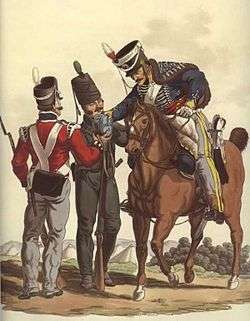King's German Legion
| King's German Legion | |
|---|---|
|
Members of the King's German Legion | |
| Active | 1803–16 |
| Country | Electorate of Hanover; since 1814 Kingdom of Hanover |
| Branch | British Army |
| Type | Legion of mixed troops: cavalry, infantry, and artillery. |
| Size | approximately 14,000 [1] |
| Garrison/HQ |
Infantry at Bexhill-on-Sea Cavalry at Weymouth, Dorset |
| Battle honours |
|
| Commanders | |
| Notable commanders | Eberhardt Otto George von Bock |
The King's German Legion (KGL) was a British Army unit of mostly expatriate German personnel during the period 1803–16. The Legion achieved the distinction of being the only German force to fight without interruption against the French during the Napoleonic Wars.
The Legion was formed within months of the dissolution of the Electorate of Hanover in 1803, and constituted as a mixed corps by the end of 1803. Although The Legion never fought autonomously and remained a part of the British Army during the Napoleonic Wars (1804–15), it played a vital role in several campaigns, most notably the Walcheren Campaign, the Peninsular War, and the Hundred Days (1815).
The Legion was disbanded in 1816. Several of the units were incorporated into the army of the Kingdom of Hanover, and became later a part of the Imperial German Army after unification in 1871.
The British German Legion, recruited for the Crimean War, is sometimes erroneously referred to as the "King's German Legion".
History
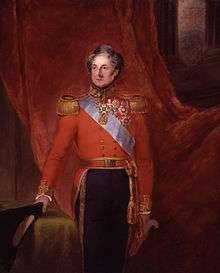
After the occupation of Hanover by Napoleonic troops the Convention of Artlenburg, also called the Convention of the Elbe, was signed on 5 July 1803 and formally dissolved the Electorate of Hanover. Consequently, the Elector's army was disbanded. Many former Hanoverian officers and soldiers fled the French occupation of Hanover to Britain; George III, the deposed Elector of Hanover, was also King of the United Kingdom.[2] The same year, Major Colin Halkett and Colonel Johann Friedrich von der Decken were issued warrants to raise a corps of light infantry, to be named "The King's German Regiment". On 19 December 1803, Halkett's and von der Decken's levies were combined as a basis of a mixed corps (includes all arms: mounted, infantry, artillery) renamed the King's German Legion. The KGL infantry were quartered in Bexhill-on-Sea and the cavalry in Weymouth, Dorset.[3][4] Some units were involved in a street fight in Tullamore, Ireland with a British Light infantry unit in the so-called Battle of Tullamore.[5][6] The number of Officers and Other Ranks grew over time to approximately 14,000, but during the 13 years of its existence, close to 28,000 men served in the Legion at one time or another. Initially, most of the officers were appointed with temporary rank, but in 1812 all the officers of the Legion were given permanent rank in the British Army for 'having so frequently distinguished themselves against the enemy.'[7] It saw active service as an integral part of the British Army from 1805–1816, after which its units were disbanded.
.jpg)
Organisation
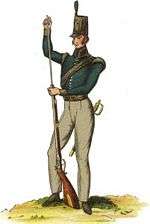
Cavalry
- 1st Regiment of Dragoons (1804–1812, red jacket)
- changed into: 1st Regiment of Light Dragoons (1812–1816, blue jacket)
- 2nd Regiment of Dragoons (1805–1812, red jacket)
- changed into: 2nd Regiment of Light Dragoons (1812–1816, blue jacket)
- 1st Regiment of Hussars
- 2nd Regiment of Hussars
- 3rd Regiment of Hussars
Infantry
- 1st Light Infantry Battalion
- 2nd Light Infantry Battalion
- 1st Line Battalion
- 2nd Line Battalion
- 3rd Line Battalion
- 4th Line Battalion
- 5th Line Battalion
- 6th Line Battalion
- 7th Line Battalion
- 8th Line Battalion
Artillery and engineers [8]
- King's German Artillery
- 2 horse batteries
- 4 foot batteries
- King's German Engineers
Campaigns
Although the Legion never fought autonomously, its units participated in campaigns in Hanover, Pomerania, Copenhagen and Walcheren, the Peninsular War under General Sir John Moore; and the retreat to Corunna; the Peninsular Campaign under the Duke of Wellington, including the battles of Bussaco, Barrosa, Fuentes de Onoro, Albuera, Ciudad Rodrigo, Salamanca, Garcia Hernandez, Burgos, Venta del Pozo, Vittoria, San Sebastian, Nivelle, Orthez, Sicily and the eastern parts of Spain, Northern Germany and Göhrde.
In the Peninsular Campaign, the Germans enhanced the veteran core of the British army. At Sabugal, in April 1811, several hundred German hussars augmented the Light Division, and the Hussars found the proper ford of the Coa River.[9] At the Battle of Garcia Hernandez, the Dragoons performed the unusual feat of smashing two French square formations in a matter of minutes.[10]
At the Battle of Waterloo, the 2nd Light Battalion — with members of the 1st Light Battalion and the 5th Line Battalion — defended the farmhouse and road at "La Haye Sainte." As the 5th Line Battalion under Oberst Ompteda was on its way to reinforce the defenders of Haye Sainte, the French cavalry attached to Jean-Baptiste Drouet, Comte d'Erlon's Corp I rode them down; only a few of the intended relievers survived. After a six-hour defence, without ammunition, or reinforcements, the Germans were forced to abandon the farm, leaving the buildings in shambles and their dead behind.[11]
Legacy
.jpg)
The Legion was known for its excellent discipline and fighting ability. The cavalry was reputed to be among the best in the British army.[12] According to the historian Alessandro Barbero, the King's German Legion "had such a high degree of professionalism that it was considered equal in every way to the best British units."[13] After the victory at Waterloo, the Electorate of Hanover was re-founded as the Kingdom of Hanover. However, the army of Hanover had been reconstituted even before the final battle, so that there were two Hanoverian armies in existence. In 1816 the Legion was dissolved and some officers and men were integrated into the new Hanoverian army.
Battle honours
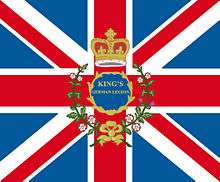
- Peninsular War
- Waterloo
- Battle of Venta del Pozo (1st and 2nd Light Infantry Battalion)
- Garcia Hernandez (near Salamanca) (1st Regiment of Dragoons )
- El Bodon (1st Regiment of Hussars)
- Barossa, near Cádiz, Spain (2nd Regiment of Hussars)
- Göhrde (3rd Regiment of Hussars)
Memorials
- Plaques on the outside wall of 'La Haye Sainte'
- Monument opposite 'La Haye Sainte' commemorating the dead of the KGL
- Hanover - the Waterloo-column
- Hanover - near the Waterloo Square in front of the archives stands a statue of Carl von Alten
- Hanover - also near the archives is a plaques commemorating Major Georg Baring
- Hanover - the Legion’s-bridge crossing the river Ihme, was originally named Waterloo-Bridge and is now renamed for the King’s German Legion
- Osnabrück - The Heger Tor, formerly called the Waterloo Tor, or the Waterloo Gate, commemorating the officers and soldiers of the KGL
- Commemorative stone at Wittingen, Lower Saxony. Inscription: Des Königs Deutsche Legion 1803–1815 - Peninsula, Waterloo, Göhrde
- On the Gehrdener mountain is a stone commemorating Carl Ludewig von Holle, fallen in Waterloo [14]
- On the monument for the Battle of Vittoria is a plaque for the KGL
 Plaque on the outside wall of La Haye Sainte
Plaque on the outside wall of La Haye Sainte- second Plaque on the wall of La Haye Sainte
 Monuments next to La Haye Sainte - the one on the left is for the KGL
Monuments next to La Haye Sainte - the one on the left is for the KGL- The Heger Tor - formerly called 'The Waterloo-Tor'. Memorial to the KGL in Osnabrück
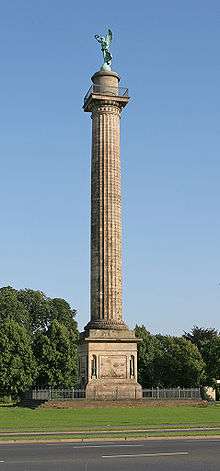 Waterloo-column in Hannover
Waterloo-column in Hannover Statue of Charles Alten in Hannover, Germany (Sculptor: Heinrich Kümmel)
Statue of Charles Alten in Hannover, Germany (Sculptor: Heinrich Kümmel) Plaque to Georg Baring in Hanover
Plaque to Georg Baring in Hanover Stone in Wittingen, Lower Saxony
Stone in Wittingen, Lower Saxony
German army

After the unification of Germany, some of the old KGL units that had served in the Hanoverian Army were perpetuated in the Imperial German Army, which eventually led to their serving in the Reichswehr and the Wehrmacht. These were:
- Kavallerie-Regiment 13–1st Regiment of Light Dragoons
- Kavallerie-Regiment 13–2nd Regiment of Light Dragoons
- Kavallerie-Regiment 14–1st Regiment of Hussars
- Infanterie-Regiment 16–1st Line Battalion
- Infanterie-Regiment 17–1st Light Battalion
See also
Sources
References
- ↑ Chapell vol. 1, p. 10
- ↑ Adkin, p.179; Beamish, preface; Chapell, vol. 1, p.39
- ↑ Beamish, vol 1, p 83
- ↑ Chappell vol 1, p. 8.
- ↑ Beamish, vol 1, p 95ff; Chappell vol 1 p 14.
- ↑ "The Battle of Tullamore - Offaly History". 2007-09-01. Retrieved 2016-09-08.
- ↑ "War Office, August 18, 1812". The London Gazette. Retrieved 2 June 2016.
- ↑ Beamish Vol 2 p 519ff
- ↑ Urban, p. 104–106.
- ↑ Smith, p. 381.
- ↑ Urban, 269, 271.
- ↑ McGrigor p. 96
- ↑ Barbero, p. 33.
- ↑ text and picture in Pfannkuche p. 108,109
Bibliography
- Adkin, Mark. The Waterloo Companion London: Aurum Press, 2001 ISBN 1-85410-764-X
- Barbero, Alessandro. The Battle of Waterloo. Walker and Company, 2005, ISBN 0-8027-1453-6.
- Beamish, N. Ludlow. History of the King's German Legion vol 1,1832 reprint Naval and Military Press, 1997 ISBN 0-9522011-0-0
- Beamish, N. Ludlow. History of the King's German Legion vol 2,1832 reprint Naval and Military Press, 1997 ISBN 0-9522011-0-0
- Chappell, Mike. The King's German Legion (1) 1803–1812. Botley, Oxford: Osprey Publishing, 2000. ISBN 1-85532-996-4.
- Chappell, Mike. The King's German Legion (2) 1812–1815. Botley, Oxford: Osprey Publishing, 2000. ISBN 1-85532-997-2.
- Mastnak, Jens. Die King's German Legion 1803–1816: Lebenswirklichkeit in einer militärischen Formation der Koalitionskriege. Celle: Bomann-Museum, 2015. (Forschungen zur Hannoverschen Militärgeschichte, 2; Zugl.: Vechta, Univ., Diss., 2013) ISBN 978-3-925902-89-5
- McGrigor, Mary: Wellington's Spies Pen and Sword Books Barnsley 2005 ISBN 1-84415-328-2
- Pfannkuche, Adolf: Die Königlich Deutsche Legion 1803–1816. 2. Auflage, Helwingsche Verlagsbuchhandlung, Hannover 1926 (de)
- Smith, Digby. The Napoleonic Wars Data Book. London: Greenhill, 1998. ISBN 1-85367-276-9
- Urban, Mark. Wellington's Rifles: Six Years with England's Legendary Sharpshooters. 2004. ISBN 0-8027-1437-4
External links
- King’s German Legion (in German) 2nd light battalion and 5th line battalion re-enactment society
- King’s German Legion (in German) 5th line battalion re-enactment group
- King´s German Legion (in German) 5th line battalion (grenadier company) re-enactment group
- King’s German Legion (in German & English)
- King's German Legion (English) Memoirs of Baron von Ompteda (download)
- King's German Legion(English)"Journal of an officer in the King's German Legion"
| Wikimedia Commons has media related to King's German Legion. |
